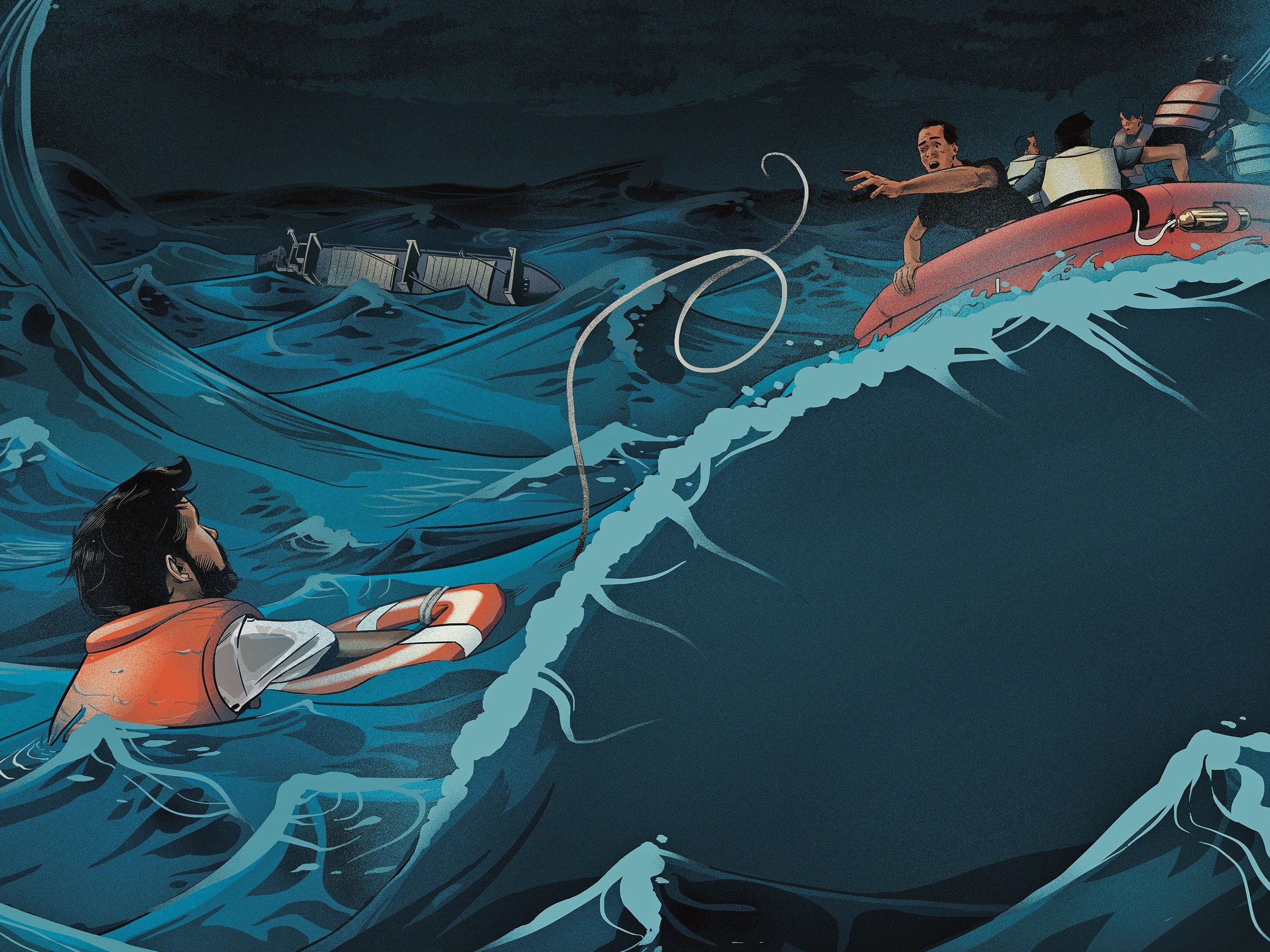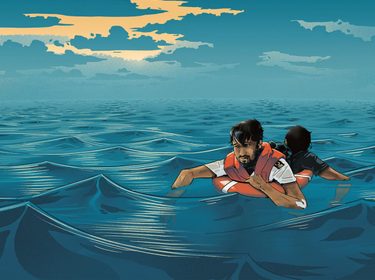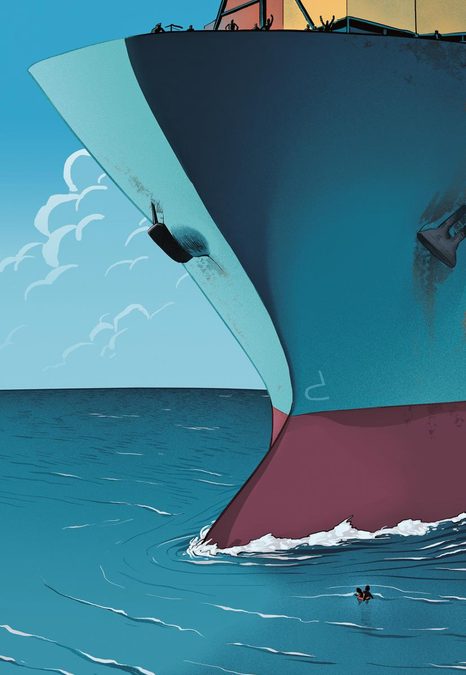
At first, only Mohammad Mobarak Hossain sensed the change-a subtle shift in the bulk freighter’s motion. It was past midnight on July 4, 2013, and the MV Hope had seen bad weather since arriving in the Andaman Sea hours before. The ship rolled right, swung back to the centre line and then heaved to the starboard side again. It was a small thing, but after five years working commercial ships in the Persian Gulf and across Asia, it was enough to convince the 25-year-old second mate that he and his 16 crewmates were in danger.
Hossain called the 54-year-old captain, rousing him from sleep. Minutes later, when Rajib Chandra Karmaker arrived on the bridge, the 97-metre vessel was already listing 15 degrees. Karmaker knew at once his shipment of mud-like ball clay, used in ceramic and tile manufacturing, had shifted in the hold. The rough seas had shaken up the cargo, liquefying it and causing the tilt. It was a situation difficult to reverse in gale-force winds.
Hossain adjusted course, pointing the vessel toward Phuket, Thailand, 90 kilometres away. He then punched a series of red buttons on the Global Maritime Distress and Safety System, and the machine emitted a chorus of high-pitched alarms. The chief officer, Mahbub Morshed-who had rushed to the bridge when he felt the ship lurch starboard-was sent down to the deck to prepare to abandon ship: assemble the men, gather life jackets, lower the lifeboat. The Hope continued to lean and was already at 30 degrees.
It was now 1 a.m., and 23-year-old deck cadet Raeq Fairooz, anxious to help, mounted the topsy-turvy stairs to find Karmaker and Hossain manning a wrecked bridge. A laptop, books and reams of paper lay scattered across the slanted floor. Blown rain and spray whipped through doors that no longer shut. Fairooz briefly took the wheel while Hossain plotted their position on the chart and Karmaker exchanged coordinates with the captain of the MV Buxmoon, a container ship 1.5 kilometres away and steaming to their aid.
The Hope now listed at 40 degrees, a house turned on its side. When the engine failed, its rumble replaced by the sound of waves smashing against the hull, there was little reason to stay on the bridge. Hossain, Karmaker and Fairooz climbed down to the deck to find that the crisis had left the other 14 men panicked and in disarray. They had not even lowered a lifeboat. The ship was grotesquely askew; doing so now would be impossible.
Two hours had passed since Hossain first felt the ship lean its shoulder into the waves. The sky was overcast and starless. Looking down from where he clung to a bulkhead, Hossain could see the starboard deck vanish into the sea. Around him, his crewmates were crying, praying and calling the Buxmoon over walkie-talkies, begging for rescue.
The previous day, the crew had left Lumut, Malaysia, in a festive mood. The Muslim holiday of Eid, marking the end of Ramadan, was just weeks away, and the men were returning to Chittagong, in southeast Bangladesh, after three months at sea. Many had purchased gifts-LED TVs, chocolates-in anticipation of the homecoming.
Those gifts now seemed destined for the sea floor. Hossain asked a deck cadet to help him haul a life raft, stored in capsule form, over the railing. With the boat inflating in the water, Hossain scrambled to the bridge to retrieve a nautical map. He returned to find all his crewmates had already leaped into the sea. Only second engineer Nazam Uddin, 30, remained on deck, surveying the scene below.
The captain was in the life raft, shouting for the two men to jump. Twelve crew members had made it to the inflatable boat, now bucking in high swells 20 metres away. But Hossain and Uddin also saw that three had not: the currents were pulling these men away, scattering them across the dark, roiling sea, the red lights of their life jackets blinking.

Hossain had no choice. He pulled on a head-to-toe immersion suit-used to regulate body temperature and promote buoyancy-and a life jacket. Before scrambling over the side, he looked at Uddin; he would never see him again. He plunged into the water. Three-metre waves threw him up, then dropped him into the gullies between them. He could barely breathe.
Through the heaving swell, he glimpsed the raft. Hossain saw the captain calling. He swam, battling the current. Karmaker reached for him. “Hold my hand,” he yelled. Hossain strained, his arm raised. He was within a metre of the raft. Moklechur Rahman, a cadet, tossed a lifebuoy. Hossain grabbed it. In a panic, the cadet dropped the line, casting Hossain adrift, helpless, out of reach.
As the lights of the raft dimmed, new ones flickered all around him-the four other men who, like Hossain, were drifting on the warm waters of the Andaman. His light was blinking also, and it was this glow that drew the Buxmoon to him.
The 164-metre container ship was coming fast. On its final voyage before dismantling at a ship-breaking yard in Chittagong, it held no cargo and was riding high, making it unwieldy. Its bulbous bow, a nose-like protuberance, was above the water. It struck Hossain.
The Buxmoon doubled back for a second try at retrieving him. Hossain was now bleeding from his right hand and leg. The ship rushed at what seemed like full speed. Hossain aimed to catch hold of a lifebuoy the crew lowered. He felt the immense propeller’s pull. Missing the buoy would mean getting sucked into those churning blades. He stopped swimming.
The ship was preparing for a third pass. Hossain resolved to catch the buoy, whatever happened. He might lose a limb, but he’d survive. It was coming now. “I maintained my position,” he says. “I wanted to survive, to go home.”
The ship hit him in the head and swept him under. His life jacket and the lifebuoy he’d received from the cadet on the raft raised him up, dragging him against the sharp marine growth of the hull. The barnacled surface tore at his scalp. He raised his left arm, letting the ship run over it instead.
He was bleeding badly when he surfaced. He kicked off the immersion suit, now in shreds, his white uniform bloodied beneath. For the fourth time he saw the Buxmoon coming at him. He covered his light and hid.
Surrendering to the drift, he watched the ship slip away in search of other survivors. Hossain began to vomit, sick from his injuries, the violent motion of the swell and swallowed sea water. Rain fell. Here and there, the lights appeared again, his crewmates shouting. They were too distant for Hossain to reach.
At 4 a.m., Hossain saw a light travelling parallel to his, ensnared in the same current. “Talk to me!” he cried. A voice replied, a silhouette against the darkness. Raeq Fairooz, the young deck cadet. They held hands and Hossain grimaced, his face lit in the glow of the life jackets. “He was heavily injured,” Fairooz says, noticing white subcutaneous flesh exposed on Hossain’s hand. “Half-dead.”
The men decided to remain together and locked arms. Dawn arrived at 5:30. In the distance, the Buxmoon shuttled to and fro, attending to the men in the raft. Then it slipped from view.

Likely because he wore a canvas backpack beneath it, Fairooz’s life jacket came loose. A wave tore it from him. “I saw it floating on top of the swell,” Hossain says. Fairooz moved to retrieve it, but Hossain stopped him. “You will be lost also,” he said. Fairooz wept, still retaining the formal language of maritime hierarchy: “What will become of me? I will die, sir.” Only Hossain’s injured hands sustained him at the water’s surface. “Don’t worry. I have a lifebuoy and a life jacket,” Hossain said. “Please climb up on my back.”
Thin and compactly built, the two men fit inside a single lifebuoy. Their dark heads were specks of black against a dark sea. Back to back, they kept watch. At 9 a.m., they spotted a blue-hulled ship 10 kilometres away. A helicopter hovered nearby. They shouted, whistled. Fairooz raised the life jacket, waving it around. The swell hid it all. Soon these rescuers, too, vanished.
Hossain noted the sun’s position and saw they were chasing it west, away from the coast and the traffic of the commercial route. His best estimate is that they’d drifted 10 kilometres from where they had abandoned the Hope. The chances of rescue were waning. A small black bird circled them. Sharksuckers, silver fish under a metre in length, took turns nibbling at their extremities-especially, Hossain says, “in the injured places.”
Hossain asked Fairooz to jettison his backpack. It was nearly empty-why not turn it over to the swell? “All the time I was asking, ‘What is inside?'” Hossain says. Fairooz wouldn’t say. “Let’s see how long I can hold it,” he’d reply. Hossain left him alone. “I thought there might be something special to keep for his last moments,” he says. “A girl’s picture, a letter.”
For his part, Hossain embraced stoicism. “I knew I’d die. By sinking, by the Buxmoon, losing my energy, eaten by sharks. No problem. I accepted it.” Fairooz, holding fast to his bag, was less philosophical. “When you lose every hope you have, that’s death,” he says. “To live, you have to have an inch of feeling for this world.”
Despair continued to afflict Hossain. He thought of his widowed mother. She’d never know for certain how he died. How would she cope? “Ammu,” he wept. Mother. “Forgive me!” The waves slapped him in the face. He could take no more and wanted to remove his life jacket and sink. “Wait,” Fairooz said. “After sunset maybe they’ll come. Just wait.”
They heard screaming at sunset and peered into the waves. Hossain illuminated his life jacket light. It was a man, too distant to identify. He would dip behind a swell and vanish, rise and reappear again. He gripped a lifeless body. A fishing boat cut through the rolling sea, unaware of the drifting men. The sun set: it was 6:50 p.m., 17 hours since they had abandoned the Hope. Hossain’s life jacket light blinked unsteadily, then died. “We spent the night in darkness,” he says.
Chilled, Fairooz asked if he could hold Hossain for warmth. Hossain agreed. Fairooz rested his head on Hossain’s back, shielding it there from the pounding swell, his legs around Hossain’s waist. He slept. Before midnight he started awake, crying. Now it was Fairooz who wanted to sink beneath the sea’s surface. “If you go, I will go,” Hossain said. “Don’t.” Fairooz slept again. Despite his injuries, Hossain was able to stay alert. The lights of fishing nets shimmered ahead. He envisioned men at daybreak hauling them in. He woke Fairooz, encouraging him to swim with him to that constellation of lights.
They swam, slept, swam again. For Hossain, the world took on an otherworldly hue. The fog of hypothermia was setting in, a danger even in the Andaman, where, in July, water temperatures hover in the high 20s. Hossain suddenly found himself at home, talking to his mother. He gave instructions on how to resolve the loose ends of his short life. As he dreamt, the waves lapped at his eyes. The sea calmed, the sky cleared, the sun came into view. Hossain felt a lightness. The bag. Where was the bag? Fairooz had surrendered it to the waters. The two men were silent, drifting in and out of reverie.
The mayday Hossain had sent some 30 hours before arrived at a receiving station in Toulouse, France, which relayed it to authorities in Thailand and ultimately to the Royal Thai Navy’s Third Area Command, on Phuket. It was an unusually serious call. Although Phuket is a busy tourist destination with a high-traffic commercial maritime route nearby, large-scale incidents take place here only once every three or four years.
Rear Admiral Prayuth Phutien got word of the accident at 6 a.m. on July 4, dispatching the 95-metre HTMS Pattani, a navy search-and-rescue vessel. Two navy helicopters joined it, and a small turboprop reconnaissance aircraft began combing a 40-kilometre-radius search area. More than 200 navy personnel contributed to the operation, as did a network of nearby fishing and other commercial ships.
It was the MV Buxlagoon-a sister ship to the Buxmoon-that spotted Hossain and Fairooz drifting off the Thai mainland at 3:30 p.m. on the second day of their ordeal. When Hossain regained consciousness, he saw the 163-metre ship towering above them. Men on deck were shouting.
Fairooz grabbed one lifebuoy lowered from above, Hossain another. Crewmen towed Fairooz to midship, where he clambered up a dangling ladder. But Hossain was too weak. He floated below the curvature of the hull, and the current dragged him under the ship, aggravating his injuries. Hossain shut his eyes and let go of the line, casting himself adrift once more.
When he came to, the Pattani, notified by the Buxlagoon of his location, hovered in the sea before him. High above, men were asking him to approach the hull. Hossain was wary. No. He would not go near the rough surface of the ship. He couldn’t quite raise his head. From each side of him, two navy divers surfaced and pulled him into their arms. It was 4:05 p.m.
When Phutien saw Hossain, he’d just arrived by helicopter and was poised for dispatch by ambulance to Vachira Phuket Hospital. “He was half-conscious, badly sunburned, and his mouth was cracked and swollen,” he says. Hossain had worried he might lose his left hand, where the Buxmoon‘s hull tore away the flesh. But doctors saved it, slicing off the infected tissue and grafting skin from his thigh over the wound. He spent a month in hospital.
Hossain was one of nine survivors of the disaster, and the last to be rescued-almost 40 hours after first plunging into the swell. (Of the 12 men in the raft, which capsized during a rescue attempt, the Buxmoon retrieved five; Karmaker was never found.)
Two months after the accident, Hossain saw Fairooz again for the first time in Chittagong. They greeted each other with hugs. “We thanked the Almighty that He saved us both-we thanked each other,” says Fairooz.
Today Hossain is second officer on a commercial vessel in the Persian Gulf. Fairooz spent a year trying to forget his time adrift on the waves. They have never discussed their ordeal together. Hossain still does not quite know what Fairooz kept for so long in that bag slung across his shoulders. Fairooz says it does not matter.